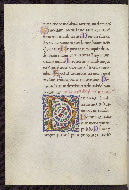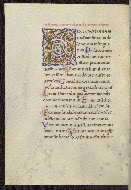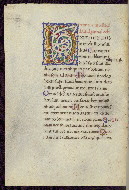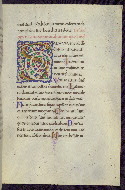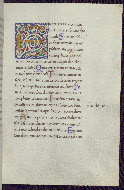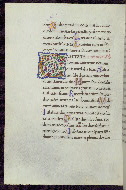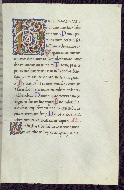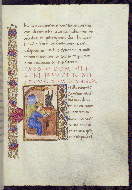Home > Digitized Walters Manuscripts
This document is a tranformation of a TEI P5 XML manuscript description incorporating images. If you have trouble reading special or non-Latin characters on this page, please make sure you have appropriate Unicode fonts installed and an up-to-date web browser.
Walters Ms. W.330, Psalter
Browse images (Browse images in a new window) | TEI in XML format
W.330
Psalter
This Psalter was created in Southern Italy, likely Naples, in the last quarter of the fifteenth century. The litany (fols. 158v - 161r) suggests it was for Cistercian use. It contains six high-quality miniatures attributed to the Neopolitan illuminator Cristoforo Magorana (though the historiated initial of David playing a psaltry on fol. 15r may have been done by another hand), who from 1480-1492 worked at the court of Ferdinand I of Aragon. To date, almost forty manuscripts have been attributed to the artist. The Walters manuscript contains two full-page miniatures, one showing the Tree of Jesse and the other the Man of Sorrows. The Tree of Jesse (described in Isaiah 1:11) shows the ancestry of Christ rising from Jesse of Bethlehem, the father of King David who is depicted on the facing folio (171r). In this depiction Jesse is shown on the trunk of the tree, but it actually rises from Abraham. Surrounding Abraham is a crowd of Prophets each with scrolls with verses believed to prophecy the coming of Christ. The miniature with the Man of Sorrows shows Christ standing in his tomb and surrounded by the objects associated with the Passion (arma Christi). The miniature follows a specific Man of Sorrows iconography that originated in an early-fourteenth century mosaic icon from Constantinople that most likely arrived in Italy ca. 1380. The mosaic panel was believed to be an authentic representation of St. Gregory's vision of Christ as the Man of Sorrows, and this type of image encouraged the viewer to meditate on the suffering of Christ while reading the Passion narratives that follow. The humanist script and white-vine initials place the Walters Psalter firmly within the Humanist tradition of the late fifteenth century. Remnants of black velvet suggest this book once had a chemise binding, comparable to W.294 and W.480. Peter Kidd has suggested that the manuscript may have been written by Pietro Ursuleo of Capua (d. 1483).
Last quarter of the 15th century CE
Naples, Italy
Supplied name: Cristoforo Majorana (flourished c. 1480-94)
Supplied name: Pietro Ursuleo of Capua (d. 1483) (?)
Book
Devotional
Scriptural
The primary language in this manuscript is Latin.
Parchment
Cream colored, fine parchment; pastedowns and flyleaves are original parchment
Foliation: i + 204
Modern pencil foliation, upper right corners, rectos; fol. 204 is numbered but is a blank flyleaf
Formula: Quire 1: 12 (fols. 1-12), Quire 2: 2 (fols. 13-14); Quire 3-12: 12 (fols. 15-134); Quire 13: 10 (fols. 135-144); Quire 14-15: 12 (fols. 145-168); Quire 16: 4 (fols. 169-172); Quire 17: 8 (173-180); Quire 18: 16 (fols. 181-194); Quire 19: 10 (fols. 195-204)
Catchwords: Occasional catchwords (as on fol. 144v); lower right corner, versos; some catchwords towards the front of the manuscript trimmed off when book was re-bound
Comments:
15.2 cm wide by 21.6 cm high
8.3 cm wide by 14.0 cm high
- Columns: 1
- Ruled lines: 19
- First line of text is above the topmost ruled line
- Title: Psalter
- Scribe: Pietro Ursuleo of Capua (d. 1483) (?)
- Artist: Cristoforo Majorana (flourished c. 1480-94)
- Hand note: Written in Humanist script
- Decoration note: Two full-page miniatures (fols. 14v and 170v), one at the beginning of the Psalms and one at the beginning of the Gospel Passion Narrative; five historiated initials of David and the Four Evangelists (fols. 15r, 171r, 181r, 189r, 197r); four fully illuminated borders; one heraldry medallion (fol. 15r); seven decorated initials (6-7 lines) (fols. 34v, 47v, 59v, 72r, 87r, 100v, 115r) at beginning of select Psalms; small (2-3 line) decorated initials introducing each Psalm; alternating gold leaf initials (1 line) with purple pen trails and blue initials with red pen trails before each Psalm verse; rubrics in red; text in black ink
- Title: Calendar
- Rubric: Januarius habet dies XXXI luna xxx nox habet horas XVI dies vero VIII
- Contents: Calendar one hall full, contents suggest Cistercian use
- Title: Psalms
- Rubric: Incipit liber hymnorum vel solioquiorum prophete David de Christo
- Incipit: Beatus vir qui non abiit in consolio impirorum
- Contents: Eight-partite division at Psalms 1, 26, 38, 52, 68, 80, 97, and 109
- Decoration note: Large (6-7 lines) decorated initials at fols. 34v, 47v, 59v, 72r, 87r, 100v, and 115r
- Title: Canticles
- Rubric: Canticum Ysaie prophete
- Incipit: Confitebor tibi domine quoniam
- Contents: Begins with the Canticle of Isaiah (Isaiah 12:1-6)
- Title: Cistercian Litany
- Rubric: Incipit letania secundum ordinem Cisterniensium
- Incipit: Kyrie leyson xpe leyson
- Title: Additional Canticles for Feast Days and Sundays
- Rubric: Cantica dominicis diebus inserto Sancti Michaelis
- Incipit: Domine miserere nostri te enim expectavimus
- Contents: A selection of additional canticles for feast days such as Michaelmas and Easter
- Title: Gospel Passion Narratives
- Rubric: Passio Domini Nostri Iesu Christi Secundum Matheum
- Incipit: In illo tempore dixit Jesus discipulis suis
- Contents: The Passion of Christ from each of the four Gospels (in the order of Matthew, Mark, Luke, and John)
- Decoration note: The cycle is preceded by a full-page miniature of Christ as the Man of Sorrows, and the narrative of each Evangelist is preceded by a historiated initial depicting them (Matthew at fol. 171r, Mark at fol. 181r, Luke at fol. 189r, and John at fol. 197r)
fol. 14v:
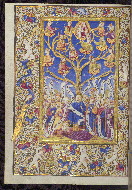
- Title: Tree of Jesse and illuminated border with putti and peacocks
- Form: Full-page miniature
- Text: Beginning of the Psalms
- Comment:
Illumination attributed to Cristoforo Majorana (active ca. 1480-1494)
fol. 15r:
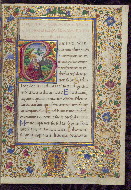
- Title: Initial "B" with David playing a psaltery, illuminated border with putti, a doe, rabbit, and heraldry
- Form: Historiated initial "B," 7 lines
- Text: Beginning of Psalm 1
fol. 34v:
fol. 47v:
fol. 59v:
fol. 72r:
fol. 87r:
fol. 100v:
fol. 115r:
fol. 170v:
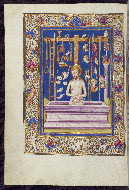
- Title: The Man of Sorrows and illuminated border with putti, birds, and inscription
- Form: Full-page miniature
- Text: Beginning of the Passion narratives
- Comment:
The scroll in the border reads: " ADORAMUS TE CHRISTE BENEDICIMUS"
Illumination attributed to Cristoforo Majorana (active ca. 1480-1494)
fol. 171r:
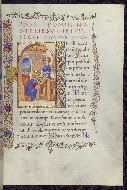
- Title: Initial "I" with St. Matthew reading
- Form: Historiated initial "I," 11 lines
- Text: Matthew's narrative of the Passion
fol. 181r:
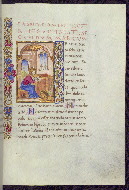
- Title: Initial "I" with St. Mark reading
- Form: Historiated initial "I," 10 lines
- Text: Mark's narrative of the Passion
fol. 189r:
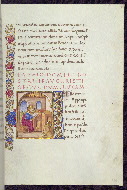
- Title: Initial "I" with St. Luke reading
- Form: Historiated initial "I," 8 lines
- Text: Luke's narrative of the Passion
fol. 197r:
The binding is original.
Fifteenth- or sixteenth-century blind tooled black leather binding over wood boards; tooling in the form of three borders, two with arabesque decoration and one with foliage; remains of a black velvet chemise cover visible on the interior of the top and bottom boards at the edges of the pastedowns; edges are full gilt with gauffered cable-work decoration; the silver gilt catches and hinges of now-missing clasps still preserved and in the form of dog-headed man grasping two dragons; the clasp plates are from an earlier book, possibly thirteenth-century German; likely re-bound since some catchwords towards the front of the manuscript seem to have been cut and some marginalia are partially missing
Created in Southern Italy (Naples) in the last quarter of the fifteenth century CE (the illuminator, Cristoforo Majorana, was active ca. 1480-1492); heraldry on fol. 15r likely represents the original owners of the manuscript; made for Cistercian use (Cistercian litany begins fol. 158v)
Henry Walters, Baltimore, purchased from Leo S. Olschki (bookseller, Florence) before 1931 (inv. 35718)
Walters Art Museum, 1931, by Henry Walters' bequest
De Ricci, Seymour. Census of Medieval and Renaissance Manuscripts in the United States and Canada. Vol. 1. New York: H. W. Wilson Company, 1935, p. 774, cat. no. 109.
Walters Art Gallery, and Dorothy Eugenia Miner. Illuminated books of the Middle Ages and Renaissance; an exhibition held at the Baltimore Museum of Art, January 27-March 13. Organized by the Walters Art Gallery in cooperation with the Baltimore Museum of Art. Baltimore: Trustees of the Walters Art Gallery. 1949, no. 174.
Walters Art Gallery. The History Of Bookbinding 525-1950 A.D. Organized By The Walters Art Gallery And Presented In Cooperation With The Baltimore Museum Of Art. Baltimore: The Trustees of the Walters Art Gallery. 1957, p. 52, no. 121.
Daneu Lattanzi, A. “Di alcuni codici miniati attribuibili a Matteo Felice e bottega (e di qualche altro codice della scuola napoletana del Quattrocento),” La Bibliofilia 75 (1973), pp. 1-43, esp. pp. 40-41.
Bagnoli, Martina, ed. A Feast for the Senses: Art and Experience in Medieval Europe. Baltimore: The Walters Art Museum, 2016, p. 149, no. 43 (catalog entry by Y. Han).
Principal cataloger: Berlin, Nicole
Cataloger: Walters Art Museum curatorial staff and researchers since 1934
Editor: Herbert, Lynley
Conservator: Quandt, Abigail
Contributors: Emery, Doug; Han, Yuna; Tabritha, Ariel; Wiegand, Kimber
The Walters Art Museum
Licensed for use under Creative Commons Attribution-ShareAlike 3.0 Unported Access Rights, http://creativecommons.org/licenses/by-sa/3.0/legalcode. It is requested that copies of any published articles based on the information in this data set be sent to the curator of manuscripts, The Walters Art Museum, 600 North Charles Street, Baltimore MD 21201.
